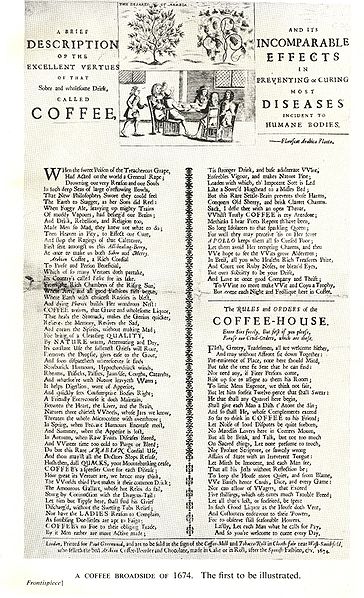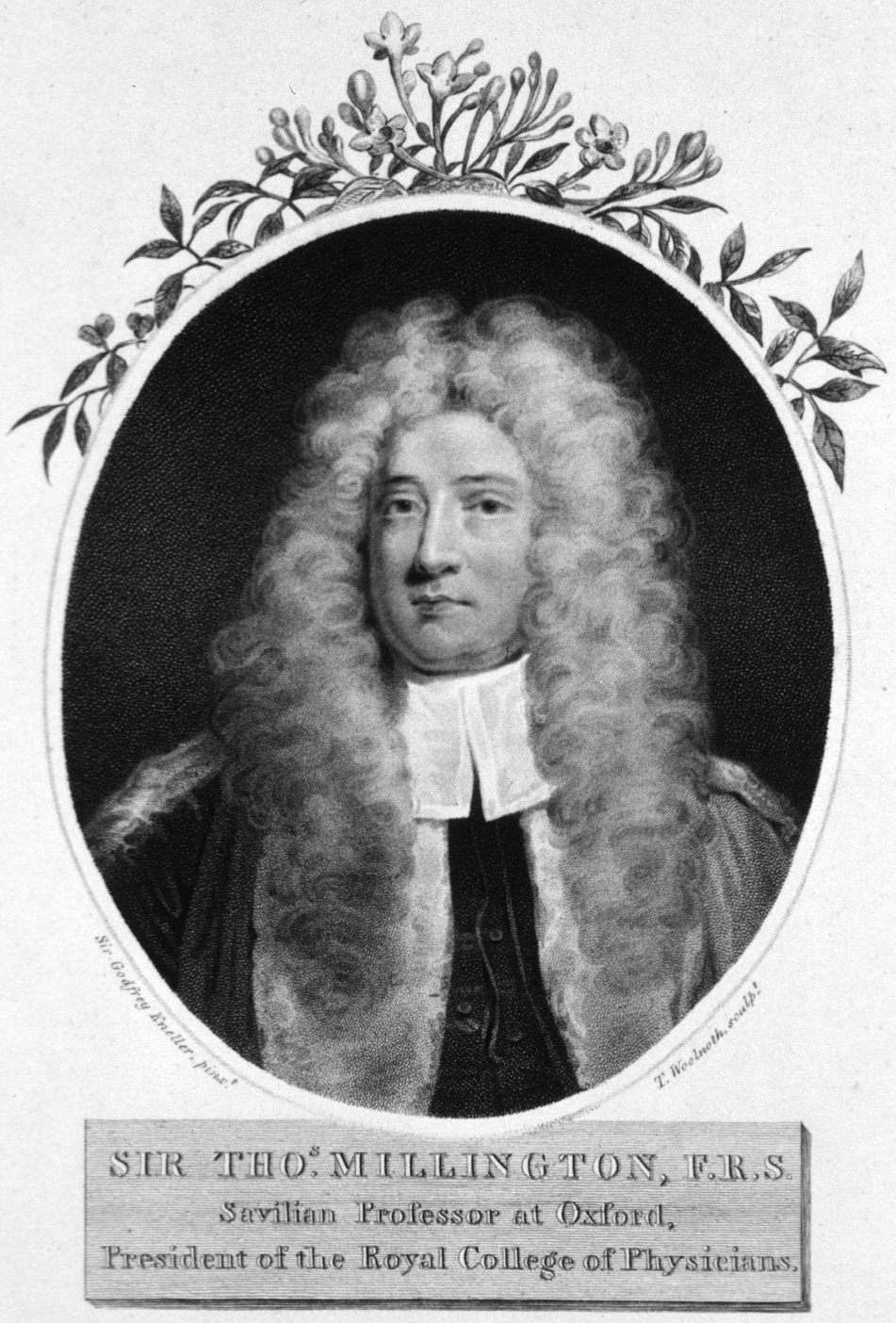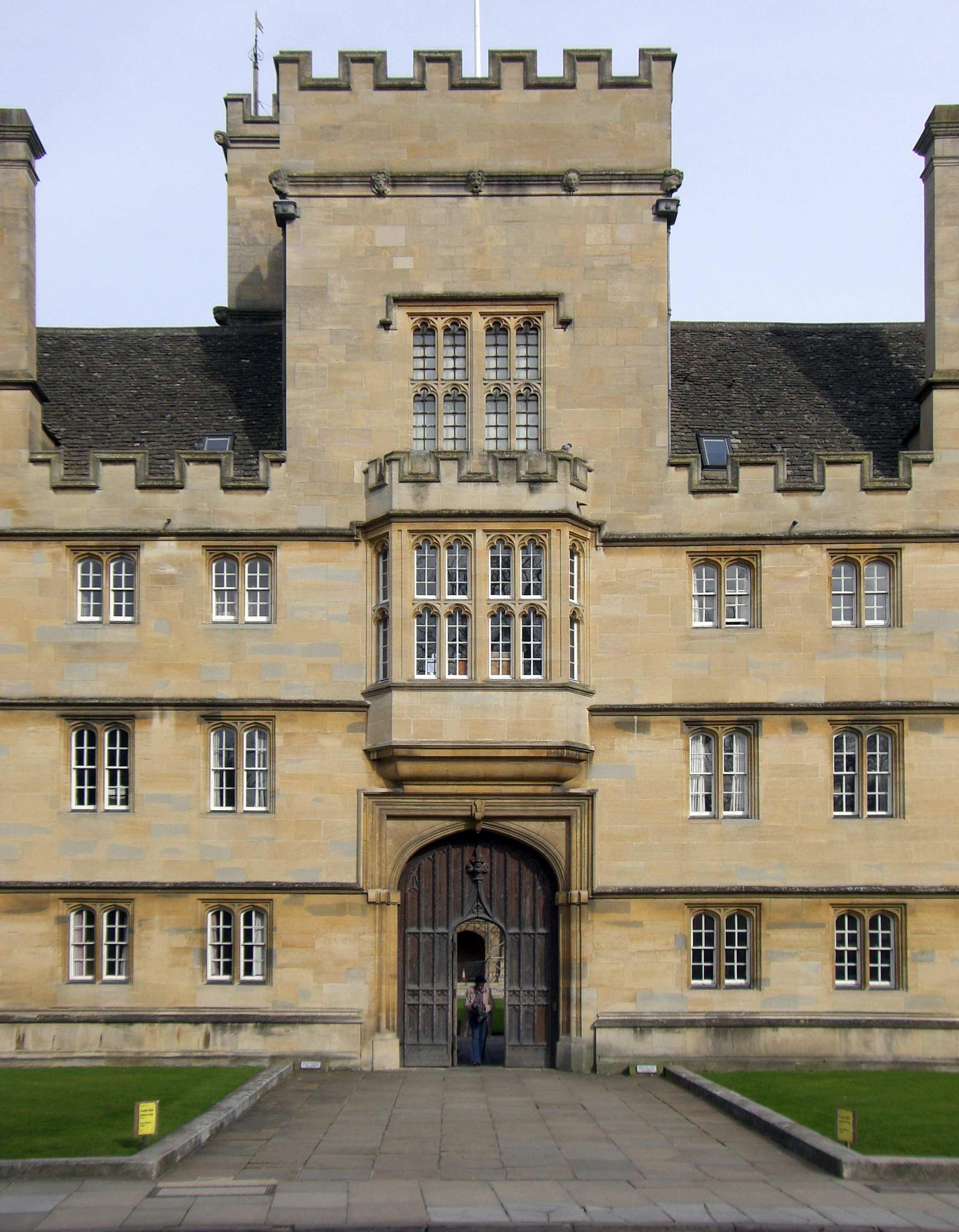|
English Coffeehouses In The 17th And 18th Centuries
In 17th- and 18th-century England, coffeehouses served as public social places where men would meet for conversation and commerce. For the price of a penny, customers purchased a cup of coffee and admission. Travellers introduced coffee as a beverage to England during the mid-17th century; previously it had been consumed mainly for its supposed medicinal properties. Coffeehouses also served tea and hot chocolate as well as a light meal. The historian Brian Cowan describes English coffeehouses as "places where people gathered to drink coffee, learn the news of the day, and perhaps to meet with other local residents and discuss matters of mutual concern." The absence of alcohol created an atmosphere in which it was possible to engage in more serious conversation than in an alehouse. Coffeehouses also played an important role in the development of financial markets and newspapers. Topics discussed included politics and political scandals, daily gossip, fashion, current events, an ... [...More Info...] [...Related Items...] OR: [Wikipedia] [Google] [Baidu] |
Maximilien Misson
Francis Maximilian Misson, originally François Maximilien Misson (c.1650 – 12 January 1722), was a French writer and traveller. Born in Lyon, he fled France at the revocation of the Edict of Nantes The Edict of Fontainebleau (18 October 1685, published 22 October 1685) was an edict issued by French King Louis XIV and is also known as the Revocation of the Edict of Nantes. The Edict of Nantes (1598) had granted Huguenots the right to pra ... in 1685 and settled in Britain. He travelled through Italy during 1687 and 1688, and in 1691 published the ''Nouveau voyage d'ltalie'', which was to be the standard travel guide to Italy for the following fifty years. In 1698 he published his second work ''Mémoires et observations faites par un voyageur en Angleterre'',. Henri Misson is given as the author but the book is usually attributed to the author's brother, François Maximilien Mission. and in 1708 his final book ''A new voyage to the East-Indies''. References External li ... [...More Info...] [...Related Items...] OR: [Wikipedia] [Google] [Baidu] |
London
London is the Capital city, capital and List of urban areas in the United Kingdom, largest city of both England and the United Kingdom, with a population of in . London metropolitan area, Its wider metropolitan area is the largest in Western Europe, with a population of 14.9 million. London stands on the River Thames in southeast England, at the head of a tidal estuary down to the North Sea, and has been a major settlement for nearly 2,000 years. Its ancient core and financial centre, the City of London, was founded by the Roman Empire, Romans as Londinium and has retained its medieval boundaries. The City of Westminster, to the west of the City of London, has been the centuries-long host of Government of the United Kingdom, the national government and Parliament of the United Kingdom, parliament. London grew rapidly 19th-century London, in the 19th century, becoming the world's List of largest cities throughout history, largest city at the time. Since the 19th cen ... [...More Info...] [...Related Items...] OR: [Wikipedia] [Google] [Baidu] |
Garraway's Coffee House
Garraways Coffee House was a London coffee house in Exchange Alley from the period when such houses served as important places where other business was performed. Its original proprietor, Thomas Garway, was already said to be the first person in England to sell tea prior to the house's founding, and when he began to sell it here in 1657 it became the first place in England to do so. The Hudson's Bay Company conducted its first sale of furs at the coffee house in 1671. Different kinds of merchants patronised different coffee houses, with tea merchants patronising Garraway's, as well as many investors in the South Sea Bubble of the 1710s. The establishment became famous as a sandwich and drinking room, it being said that the sandwich-maker spent two hours preparing each day's food. The works of Charles Dickens include multiple references to Garraway's, and Daniel Defoe wrote of it being frequented by wealthy traders from the City. See also * References {{coords, 51.5 ... [...More Info...] [...Related Items...] OR: [Wikipedia] [Google] [Baidu] |
Tavern
A tavern is a type of business where people gather to drink alcoholic beverages and be served food such as different types of roast meats and cheese, and (mostly historically) where travelers would receive lodging. An inn is a tavern that has a licence to put up guests as lodgers. The word derives from the Latin '' taberna'' whose original meaning was a shed, workshop, stall, or pub. Over time, the words "tavern" and "inn" became interchangeable and synonymous. In England, inns started to be referred to as public houses or pubs and the term became standard for all drinking houses. Europe France From at least the 14th century, taverns, along with inns, were the main places to dine out. Typically, a tavern offered various roast meats, as well as simple foods like bread, cheese, herring, and bacon. Some offered a wider variety of foods, though it would be cabarets and later ''traiteurs'' which offered the finest meals before the restaurant appeared in the 18th century. T ... [...More Info...] [...Related Items...] OR: [Wikipedia] [Google] [Baidu] |
John Evelyn
John Evelyn (31 October 162027 February 1706) was an English writer, landowner, gardener, courtier and minor government official, who is now best known as a diary, diarist. He was a founding Fellow of the Royal Society. John Evelyn's Diary, John Evelyn's diary, or memoir, spanned the period of his adult life from 1640, when he was a student, to 1706, the year he died. He did not write daily at all times. The many volumes provide insight into life and events at a time before regular magazines or newspapers were published, making diaries of greater interest to modern historians than such works might have been at later periods. Evelyn's work covers art, culture and politics, including the execution of Charles I, Oliver Cromwell's rise and eventual natural death, the last Great Plague of London, and the Great Fire of London in 1666. ''John Evelyn's Diary'' was first published posthumously in 1818, but over the years was overshadowed by that of Samuel Pepys. Pepys wrote a differen ... [...More Info...] [...Related Items...] OR: [Wikipedia] [Google] [Baidu] |
Anthony Wood (antiquary)
Anthony Wood (17 December 1632 – 28 November 1695), who styled himself Anthony à Wood in his later writings, was an English antiquary. He was responsible for a celebrated ''Hist. and Antiq. of the Universitie of Oxon''. He meticulously researched and documented the history of Oxford, producing significant works such as the ''Historia et Antiquitates Universitatis Oxoniensis'' and the ''Athenae Oxonienses''. Despite criticism for errors and suspected biases, his works remain invaluable. Wood had free access to university records, consulted with notable scholars, and faced controversy, including banishment from the University of Oxford. Unmarried, he led a life devoted to scholarship and antiquarian pursuits. Early life Anthony Wood was born in Oxford on 17 December 1632, as the fourth son of Thomas Wood (1581–1643), BCL of Oxford, and his second wife, Mary (1602–1667), daughter of Robert Pettie and Penelope Taverner. His father, who was born in Islington and attended Br ... [...More Info...] [...Related Items...] OR: [Wikipedia] [Google] [Baidu] |
John Lamphire
John Lamphire M.D. (1614–1688) was an English academic, who became a physician after being ejected from his college fellowship. He was later Camden Professor of Ancient History, and principal of Hart Hall, Oxford. Life He was son of George Lamphire, apothecary, and was born in Winchester. He was admitted scholar of Winchester College in 1627. He matriculated from New College, Oxford in 1634, aged 20; was elected fellow there in 1636; proceeded B. A. in 1638, and M.A. in 1641-2. He is apparently the John Lanfire who was appointed prebendary of Bath and Wells in 1641. In 1648 he was ejected from his fellowship by the parliamentary visitors, but during the Commonwealth practised physic with some success at Oxford. Anthony à Wood in his 'Autobiography' says he belonged to a set of royalists "who esteemed themselves virtuosi or wits". He was Wood's physician, and tried to cure his deafness. Lamphire was restored to his fellowship in 1660, and on 16 August was elected Camden prof ... [...More Info...] [...Related Items...] OR: [Wikipedia] [Google] [Baidu] |
Timothy Baldwin
Sir Timothy Baldwin (1620–1696), was an English academic and lawyer. Biography Baldwin was the younger son of Charles Baldwin of Burwarton, Shropshire and his wife who was a daughter of Francis Holland, of Burwarton. He became a commoner of Balliol College, Oxford in 1635 and was also a student of the Inner Temple in 1635. He was awarded a Bachelor of Arts at Oxford on 13 October 1638 and in 1639 he was elected Fellow of All Souls' College, where he lived during the English Civil War. He was awarded Bachelor of Civil Law on 26 June 1641. As a royalist he was deprived of his fellowship by the Parliamentary Commissioners in 1648, but an application on his behalf to the wife of Thomas Kelsey, deputy-governor of the city of Oxford, accompanied by "certain gifts", secured his speedy reinstatement. In 1652 he was awarded Doctor of Civil Law. He is mentioned by Wood in his autobiography (ed. Bliss, p. xxv) as joining in 1655 a number of Royalists "who esteem'd themselves either vi ... [...More Info...] [...Related Items...] OR: [Wikipedia] [Google] [Baidu] |
Thomas Millington (physician)
Sir Thomas Millington FRS (1628 in Newbury – 5 January 1703/04 in Gosfield), the son of Thomas Millington, was an English physician. Greatly respected in his day, he was eulogised by Samuel Garth under the name of ''Machaon'' in his poem "The Dispensary", and Thomas Sydenham held him in high regard. Life Thomas Millington received his education at Richard Busby's Westminster School, and then in 1645, at Trinity College, Cambridge under James Duport. From here he graduated AB in 1649, and moved on to Oxford University, obtaining his AM. He was elected a fellow of All Souls College and became a doctor of medicine at Oxford on 9 July 1659. In the preface to the 1664 work ''Cerebri anatome'', Thomas Willis describes him as a "most learned man, to whom I from day to day proposed privately my Conjectures and Observations, often confirmed by his Suffrage, being uncertain in mind, and not trusting to my own opinion". Appointed to the chair of Sedleian Professor of Natural Phil ... [...More Info...] [...Related Items...] OR: [Wikipedia] [Google] [Baidu] |
Peter Pett (shipwright, Died 1672)
Peter Pett (6 August 1610 – 1672) was an English Master Shipwright and Second Resident Commissioner of Chatham Dockyard. He protected his scale models and drawings of the King's Fleet during the Dutch Raid on the Medway, in Kent in June 1667, during the Second Anglo-Dutch War, which was otherwise disastrous to the British Royal Navy. Life Pett was the son of the King's Master Shipwright Captain Phineas Pett. He was introduced to King Charles I of England in 1634 and was ordered to construct a new Third Rate ship of 500 tons at Woolwich Dockyard, to be named English ship Leopard (1635), ''Leopard''. With the construction of the ''Leopard'' underway, Charles decided that he would have a ship built larger and more ornate than any of her predecessors. In June 1634 while at Woolwich and on the ''Leopard'' with the king, Phineas Pett, Peter's father, related: "His Highness, calling me aside, privately acquainted me of his princely resolution for the building of a great new ship, whic ... [...More Info...] [...Related Items...] OR: [Wikipedia] [Google] [Baidu] |
Christopher Wren
Sir Christopher Wren FRS (; – ) was an English architect, astronomer, mathematician and physicist who was one of the most highly acclaimed architects in the history of England. Known for his work in the English Baroque style, he was accorded responsibility for rebuilding 52 churches in the City of London after the Great Fire in 1666, including what is regarded as his masterpiece, St Paul's Cathedral, on Ludgate Hill, completed in 1710. The principal creative responsibility for a number of the churches is now more commonly attributed to others in his office, especially Nicholas Hawksmoor. Other notable buildings by Wren include the Royal Hospital Chelsea, the Old Royal Naval College, Greenwich, and the south front of Hampton Court Palace. Educated in Latin and Aristotelian physics at the University of Oxford, Wren was a founder of the Royal Society and served as its president from 1680 to 1682. His scientific work was highly regarded by Isaac Newton and Blaise ... [...More Info...] [...Related Items...] OR: [Wikipedia] [Google] [Baidu] |






